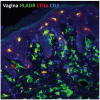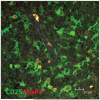Mucosal immunology of HIV infection
- PMID: 23772612
- PMCID: PMC3693769
- DOI: 10.1111/imr.12072
Mucosal immunology of HIV infection
Abstract
Recent advances in the immunology, pathogenesis, and prevention of human immunodeficiency virus (HIV) infection continue to reveal clues to the mechanisms involved in the progressive immunodeficiency attributed to infection, but more importantly have shed light on the correlates of immunity to infection and disease progression. HIV selectively infects, eliminates, and/or dysregulates several key cells of the human immune system, thwarting multiple arms of the host immune response, and inflicting severe damage to mucosal barriers, resulting in tissue infiltration of 'symbiotic' intestinal bacteria and viruses that essentially become opportunistic infections promoting systemic immune activation. This leads to activation and recruitment or more target cells for perpetuating HIV infection, resulting in persistent, high-level viral replication in lymphoid tissues, rapid evolution of resistant strains, and continued evasion of immune responses. However, vaccine studies and studies of spontaneous controllers are finally providing correlates of immunity from protection and disease progression, including virus-specific CD4(+) T-cell responses, binding anti-bodies, innate immune responses, and generation of antibodies with potent antibody-dependent cell-mediated cytotoxicity activity. Emerging correlates of immunity indicate that prevention of HIV infection may be possible through effective vaccine strategies that protect and stimulate key regulatory cells and immune responses in susceptible hosts. Furthermore, immune therapies specifically directed toward boosting specific aspects of the immune system may eventually lead to a cure for HIV-infected patients.
© 2013 John Wiley & Sons A/S. Published by John Wiley & Sons Ltd.
Figures





References
-
- Granich R, Williams B, Montaner J. Fifteen million people on antiretroviral treatment by 2015: treatment as prevention. Curr Opin HIV AIDS. 2013;8:41–49. - PubMed
-
- Shattock RJ, Warren M, McCormack S, Hankins CA. AIDS. Turning the tide against HIV. Science. 2011;333:42–43. - PubMed
-
- Rerks-Ngarm S, et al. Vaccination with ALVAC and AIDSVAX to prevent HIV-1 infection in Thailand. N Engl J Med. 2009;361:2209–2220. - PubMed
-
- Mofenson LM. Interaction between timing of perinatal human immunodeficiency virus infection and the design of preventive and therapeutic interventions. Acta Paediatr Suppl. 1997;421:1–9. - PubMed
Publication types
MeSH terms
Substances
Grants and funding
LinkOut - more resources
Full Text Sources
Other Literature Sources
Medical
Research Materials

